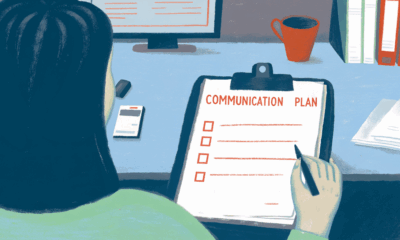Leading with Impact
The Rise of Resilient Leadership

The world isn’t just changing – it’s shaking. Volatility doesn’t knock politely anymore; calling recent events “surprises” feels almost generous. Pandemics. Wars and rising conflicts. Economic crises. Government shutdowns. Nationwide protests. And now, the dizzying acceleration of AI. Tomorrow feels impossible to predict. Already, it’s a lot for one person to process. And yet, some are expected to hold everyone else together.
Leaders no longer simply guide teams. They are emotional anchors when the ground drops beneath everyone’s feet. They absorb panic, model steadiness, and keep the team from tipping over. Research from DDI shows that when leaders provide consistent support and model resilience, employees are three times more likely to stay engaged, even under pressure.
Resilience has become the baseline for survival – the quality that separates teams that crumble under pressure from those that keep moving forward, no matter what comes next.
In this article, we unpack what resilience in leadership truly means, the traits that define modern resilient leaders, practical strategies to build these essential skills, and the common pitfalls that can quietly sabotage your ability to lead through turbulence – often before you even realize it.
What is resilience?
Resilience is the quiet strength that allows you to endure setbacks, regain balance, and keep moving toward your goals. In corporate terms, resilience means building risk and volatility into business plans, policies, and strategies. Modern organizations operate in a fast, complex global environment where unexpected and potentially damaging challenges appear without warning. The resilient ones don’t just react, they anticipate risks and put measures in place to mitigate, or even neutralize, their impact.
But resilience isn’t only about strategy or systems. In the workplace, it’s about functioning when plans fall apart, staying clear-headed under pressure, and adjusting course without shaking your team’s confidence. Organizations that embody resilience don’t crumble when circumstances shift. They maintain focus, preserve culture, and carry progress forward, even through uncertainty.
For today’s businesses, resilience has become inseparable from culture. Each day can bring surprises, disruptions, and risks no one saw coming. The ability to endure, and to rise stronger – affects not just the organization, but the lives of the people working to make it succeed. A resilient company must be able to weather hard times and, like a phoenix, emerge renewed from even the most hopeless situations.
What is resilient leadership?
In turbulent times, people tend to look for someone to lean on, someone who can inspire hope and show that moving forward is possible, no matter the circumstances. This is that type of person modern leader needs to be. Not a superhero who can solve everything or deliver perfect outcomes, but a human who embraces vulnerability, acknowledges setbacks, and leads by example. A resilient leader shows that life isn’t a steadily rising graph but a heartbeat, full of peaks and dips, each inevitable and instructive. Even in moments of burnout, they demonstrate that the outcome depends on how we respond: do we collapse into despair, or learn from the missteps, adjust our strategy, and try again with the lessons in hand?
Resilient leadership is the practice of guiding teams and organizations with adaptability, emotional steadiness, and the ability to recover quickly from setbacks. At its core, it reflects a consistent willingness to rethink, adjust, and implement changes – not only when crises strike, but as part of everyday decision-making. A resilient leader understands that different situations demand different responses and adapts their approach to ensure the healthiest and most effective path forward.
This style of leadership has gained recognition in recent years. Global disruptions like the COVID-19 pandemic and ongoing economic volatility highlighted the need for leaders who could act as stabilizing forces, keeping teams grounded and morale intact amid uncertainty. But what exactly makes a leader truly resilient?
Core qualities of a resilient leader
Resilient leaders are more than steady; they’re human, adaptable, and purposeful. They guide their teams through uncertainty with calm, clarity, and confidence. Although each leader brings his or her style to the table, the most resilient consistently demonstrate five key qualities.
- Emotional stability
A resilient leader stays grounded when stress surges and keeps a clear head when circumstances spiral. Their calm becomes a source of safety for the team. Research published in Current Psychology shows that leaders who regulate their emotions more effectively reduce team anxiety and boost engagement. Emotional stability isn’t just a personal strength – it radiates outward, shaping the entire climate of the workplace. - Adaptability
Change is inevitable, and resilient leaders quickly pivot. They adjust strategies in a snap and lead others to accept changes, not resist them. Studies on adaptive leadership repeatedly show that reframing setbacks and staying flexible are among the largest predictors of successful crisis navigation. When leaders model adaptability, teams are more likely to treat challenges as opportunities instead of roadblocks. - Decisiveness
Uncertainty often begets incomplete information. In turn, resilient leaders make decisions on time with confidence, even when the path forward is unclear. Case studies in leadership research confirm decisiveness under pressure allows organizations to maintain momentum and prevents teams from getting stuck on either over-analysis or fear. Through such decisive action, leaders infuse a sense of direction that keeps everyone forging ahead. - Empathy
Leadership is thoroughly human. Resilient leaders know disruption takes an emotional toll on people, and so they respond with empathy and support. Every piece of research and industry surveys state that empathic leaders build higher levels of trust, increase engagement, and build psychological safety. Teams follow leaders who can show they care, especially in moments of uncertainty and stress. - Strategic vision
Resilient leaders don’t just react-they anticipate.They see patterns, predict risks, and turn uncertainty into opportunities for growth. Bravanti research in resilient leadership shows that individuals who couple foresight with adaptability are better equipped for crises and foster a culture of innovation and learning. A clear, long-term vision gives teams purpose and perspective, turning immediate challenges into momentum for the future.
Taken together, these qualities allow resilient leaders to stay grounded, adapt nimbly, make decisions with confidence, and foster trust. They transform pressure into perspective and uncertainty into momentum, helping organizations navigate not only through difficulties but beyond them.
How to develop resilient leadership skills
Resilient leadership is not something with which one is born. It is developed through daily habits, reflective thought, and a desire to learn. Leaders who consistently perform well under pressure don’t simply trust their instincts; they deliberately cultivate the mindsets and practices that help them stay steady and point the way through uncertainty. Here’s how you can strengthen these skills in the real world:
- Practice self-awareness
Resilient leaders tend to know their emotional triggers and the patterns of their stress long before reaching any breaking point. This often starts with small routines: keeping a short end-of-day reflection journal, using mindfulness apps between meetings, or scheduling regular 1:1s specifically for feedback on leadership behavior. A number of executives also use “stress mapping”-identifying situations that consistently cause tension-to help them respond thoughtfully instead of reactively. - Strengthen adaptability
Adaptability shows up in everyday decisions. Think of a leader who readjusts team priorities within hours because customers’ needs changed, or who pilots a new workflow rather than forcing an outdated one. Flexible leaders test assumptions, adjust strategies based on real-time data, and invite employees to share fresh ideas. Some teams run monthly “what if” exercises, imagining sudden changes-a system failure, budget cuts, a competitor launch-to strengthen their adaptability muscles long before a real crisis hits. - Improve decision-making under pressure
When given incomplete information, resilient leaders fall back on simple, rehearsed frameworks. Many use a “clarity first” rule: define the goal, list the knowns and unknowns, choose the best option available, and communicate the reasoning openly. Others use time-boxed decision windows-for example, make a call within 30 minutes during a crisis to avoid bottlenecks. This is exactly what effective crisis response teams do: move quickly, communicate clearly, and then adjust if new data emerges. - Nurture empathy and connection
Empathy becomes real in everyday interactions. It might mean checking in personally with a stressed team member after a difficult client call, or adjusting workloads when someone is close to burnout. Many resilient leaders schedule informal “temperature checks”-short conversations designed to understand how people are coping, not just what they’re working on. These small moments build psychological safety, making teams more honest, collaborative, and resilient. - Create strategic foresight
Instead, resilient leaders zoom out, tracking emerging market shifts, competitor behavior, and holding quarterly sessions dedicated to future scenarios. Some deploy cross-functional “trend boards” that report back regularly on developments in technology, regulation, and customer behavior. The result is that leaders can get ready for the bumps ahead rather than scrambling to react when the heat is on.
By intentionally practicing these skills, leaders don’t just survive disruption – they turn it into momentum, ensuring teams remain aligned, motivated, and capable of thriving no matter what comes next.
Common mistakes resilient leaders should avoid
Even the most capable leaders can stumble if they overlook subtle pitfalls. Recognizing these common mistakes helps ensure resilience strengthens rather than undermines performance and morale.
- Confusing toughness with resilience. Staying composed under pressure is not the same as ignoring emotions. Leaders who bottle up stress or avoid difficult conversations risk eroding trust and engagement. For example, a manager who never acknowledges a team’s frustration during setbacks may create quiet resentment and reduce initiative. True resilience involves both steadiness and openness.
- Over-adapting without direction. Flexibility is essential, but constant shifts without purpose can confuse and fatigue teams. Imagine a leader who reacts to every minor challenge by changing priorities, leaving employees uncertain about what matters most. Effective resilient leaders balance adaptability with a clear vision, making it obvious how adjustments fit into long-term objectives.
- Neglecting self-care. Resilience has limits. Leaders who skip rest, neglect their mental health, or never pause to reflect risk burnout, which can compromise decision-making and their ability to support the team. It’s essential to schedule reflection time, delegate tasks strategically, and model healthy work habits for others.
- Failing to engage the team. Resilience is not a solo act. Excluding input, withholding information, or ignoring concerns weakens collective problem-solving. Teams thrive when leaders solicit feedback, foster open discussion, and actively involve them in navigating challenges. Engagement ensures that solutions are better, faster, and more sustainable.
- Ignoring organizational culture. Culture is the framework that keeps teams steady under pressure. Leaders who overlook it risk disengagement, attrition, and ethical missteps during crises. By consistently reinforcing values, encouraging transparency, and celebrating everyday contributions, leaders create an environment that endures stress while driving innovation.
Avoiding these mistakes allows leaders to not only endure crises but also cultivate stronger, more adaptive teams – transforming uncertainty into growth and opportunity.
Conclusion
The modern workplace moves fast, shifts suddenly, and often demands clarity long before clarity exists. Organizations need leaders who steady their teams in uncertainty, make thoughtful decisions under pressure, and turn disruption into forward motion. Resilient leaders do more than guide people through difficult moments; they help others stay focused, hopeful, and connected when the world feels unpredictable.
But resilience isn’t about perfection or relentless strength. It’s about showing up with honesty, learning from every stumble, and choosing to continue – even when the pace is exhausting or the path is unclear. Leaders are human long before they are anything else. They feel fear, doubt, and fatigue just like everyone around them. And that’s not a flaw, it’s a reminder that resilience grows from vulnerability, not the absence of it.
So, if you’re moving through a heavy week or a tiring season, remember this: Resilience is built one day at a time, and you don’t have to carry everything yourself. Give yourself space to rest, to breathe, to readjust, and to start again. The hard moments in life do not define you. They shape you and strengthen you, and like all seasons, they will pass.
And that, of course, is when you lead with deeper clarity, steadier judgment, and a stronger sense of purpose than before.
Leading with Impact
How to Deliver Your HR Message Without Losing the Room

You’ve prepared everything — down to the last word. Rehearsed your speech in front of the mirror more times than you’d like to admit. You’ve run the message in your head all night, barely slept, and now you’re doing your best to hide the under-eye bags. Maybe you even built a beautiful slide deck.
All that’s left is to deliver this important update to the team.
So here you are — at an all-hands, in a manager sync, over email, or, heaven help us, on a Zoom call that quickly turns into a tribute to Malevich’s suprematism. Half the cameras are off. Someone forgot to mute themselves and is now loudly unloading a dishwasher or walking through traffic. The chat pings every few seconds with off-topic questions and private jokes.
And somewhere in the middle of all that — something feels off.
Some people nod. Others are barely listening, glued to their phones. Someone hears one key detail wrong and casually repeats it to their team — only now, it sounds slightly… different. The tone shifts. The meaning drifts. Suddenly, new details appear out of nowhere, and even you start questioning what you actually said.
By the end of the day, your clear, thoughtful message has transformed into a confusing mess — sparking frustration, speculation, or worse, quiet panic.
Here’s the thing: it probably wasn’t your fault. You likely did everything right.
You can be a brilliant speaker with beautifully designed slides… but we’re all human. And working with humans? That’s the hardest part. Misunderstandings will happen. What matters is how you respond.
Sometimes, you’ll need to gently force the room to ask questions. Sure, in an open culture, people might feel free to speak up. But sometimes, drawing out questions is like pulling teeth — and if you don’t, confusion spreads faster than facts ever could.
The good news? Most of this is fixable.
That’s exactly why we put this guide together — to offer you a safety net. Or a salt circle, if you’re walking into one of those meetings. Either way, we’re here to help you say the right thing, at the right time, in the right way — whether you’re breaking tough news, rolling out changes, or just trying to get people to read a policy update without falling asleep.
So, let’s walk that HR tightrope — together.
Why internal communication matters more than ever?
Sometimes it feels like we’re being squeezed from all sides — but also handed endless new tools and opportunities. Want to work from anywhere but still drop by the office sometimes? Welcome to hybrid work. Want to speed things up and offload routine tasks? Say hello to AI-powered tools.
Of course, there’s a catch. We still have to navigate layoffs, DEI reports, and shifting company policies — all while staying empathetic, alert, and ready to solve problems for leadership and teams alike.
Employees today aren’t just watching from the sidelines. They want their voices heard and respected. With this, internal communication has become so complex you might be thinking about getting a psychology degree just to keep up.
HR leaders? They’re more than messengers — they’re culture architects and steady voices in the chaos. Think of HR as Hermes, the messenger god — tasked with carrying vital news across time zones and Zoom calls (if only we had those magical winged sandals to fly personally from desk to desk around the globe).
Without a clear communication strategy, even the most important messages risk turning into noise, confusion, or silence. Because to keep your team not just informed but truly connected, it takes more than words. It demands care, precision, and a plan.
The core of effective HR communication strategies
Let’s face it — getting your message across without it turning into a game of corporate charades is no small feat. But there are a few solid tricks (okay, proven steps) that can seriously tip the odds in your favor.
1. Know your “why” before you speak
Before you jump into drafting that email or polishing your slides, let the message settle in your own head first. Get to the core of what you’re really trying to say — and only then think about how to deliver it. Even then, hit pause and ask yourself a few key questions.
- What’s really at the heart of this update?
- Why should they care — beyond the obvious “because leadership says so”?
- What feeling do you want to leave behind — reassurance, urgency, hope?
Without a clear purpose, your message risks sounding like background noise. When your communication is rooted in a real “why,” it’s like speaking someone’s language instead of just talking at them.
2. Listen first, then communicate
Think like a detective — or a mentalist, if you prefer. Before you speak, observe. Scan the room (or the Zoom). Every detail, every vibe, might be a clue to what’s really going on. Don’t just broadcast. Investigate.
- What questions or rumors are already swirling around?
- What keeps your people up at night — stress, confusion, excitement?
- Are managers hearing the same concerns?
Try small group chats, anonymous surveys, or just eavesdropping on Slack threads (we all do it). When people feel heard before you speak, they’re way more likely to actually listen when you do.
3. Speak human, not corporate
If you want people to actually listen — talk like a human. Don’t be the corporate bot spitting out buzzwords and legalese. You’re a person, talking to other people. Keep it real.
Compare this:
“As part of our ongoing organizational realignment, we will be implementing structural changes…”
To this:
“We’re making some changes to how we’re organized — and yes, that raises questions. Let’s talk.”
Drop the jargon and speak like a real person. Your audience isn’t looking for a policy manual; they want honesty, clarity, and a voice that feels like it’s coming from a human who gets it.
4. Use emotional intelligence as your secret weapon
Empathy matters. Sometimes, it helps to flip the script — would you want to get bad news out of nowhere on a sunny Friday afternoon? Probably not. Timing can either soften the blow or make it worse.
Ask yourself:
- Is this better said face-to-face, in writing, or cascaded through managers?
- Is today the right day, or should it wait until people have had their coffee?
- Am I coming across as urgent, caring, or just plain tired?
Being emotionally smart means thinking beyond what you say to how you say it — and when.
5. Repeat. Rephrase. Reinforce.
Don’t assume they got it the first time. Or the second. A good message needs to be like a kid’s favorite song — catchy, repeated, and easy to echo. Say it, show it, repeat it… until they can sing it back to you.
Support your core message by:
- Sending follow-up FAQs that answer the questions no one dared to ask aloud
- Hosting office hours or Q&A sessions for those who prefer real-time dialogue
- Arming managers with talking points and tone guidance — because they’re your frontline communicators
- Sharing your message through multiple channels — emails, messengers, intranet, even posters if that’s your style
Repetition doesn’t mean nagging; it means giving people the space and time to really absorb what you’re saying.
The C.A.R.E. framework for HR messaging
When you’re short on time (and patience), a simple structure can help keep your message on track:
C — Clarity
Start with what matters. Skip the fluff.
- “What’s changing — and why.”
A — Audience
Know who you’re talking to.
- “What are they feeling? What do they need right now?”
R — Resonance
Speak in a way that lands — and reassures.
- “We hear your concerns and want to be honest about what’s next.”
E — Engagement
Don’t just drop the news and disappear. Invite the next step.
- “We’re holding open office hours this week — come by, ask questions, vent if you need to.”
Say it steady — even when the room is shaking
In moments of change — the kind that tightens your chest and sends Slack into overdrive — people aren’t just reading your words. They’re reading between them. The tone. The timing. The pauses that say more than the email ever could.
They’re asking themselves:
Am I safe? Can I trust this? Does anyone up there actually see what this feels like down here?
And here you are — the HR pro, the steady voice in the noise, trying to make sense of the chaos for everyone else… while processing your own reaction in real time.
Because you’re not just delivering the message. You’re living it, too.
You might be anxious. Conflicted. Tired. Frustrated that you couldn’t shape the decision more. And all of that — if left unacknowledged — can sneak into your message. In a rushed line. A vague phrase. A silence that lands too heavy.
That’s why your presence matters so much more than perfect wording. People don’t need spin. They need someone who shows up — with clarity, with empathy, with a voice that says: Yes, this is hard. And yes, I’m still here with you.
This is the real work of internal communication. It’s not about finding the perfect words — it’s about building trust. Not about staying in control — but staying connected.
Even when things get messy. Especially then.
That’s what people remember.
-

 Collaboration5 months ago
Collaboration5 months ago18 Experts Share Tips for Businesses Switching to Remote Work
-

 Communication7 months ago
Communication7 months ago6 Communication Plan Templates With Examples
-

 Collaboration6 months ago
Collaboration6 months ago30 Work From Home Memes: Funny Work Memes to Make You Laugh
-

 Collaboration7 months ago
Collaboration7 months ago6 Tips for Lifting the Burden of Too Many Responsibilities
-

 Productivity6 months ago
Productivity6 months agoSuper True Mental Health Memes You’ll Probably Relate To
-

 Collaboration8 months ago
Collaboration8 months ago35+ Collaboration Quotes to Celebrate Teamwork
-

 Collaboration7 months ago
Collaboration7 months ago7 Easy Strategies for Effective Team Communication
-

 Collaboration8 months ago
Collaboration8 months agoThe Definitive Guide to Creating an Internal Communication Strategy





